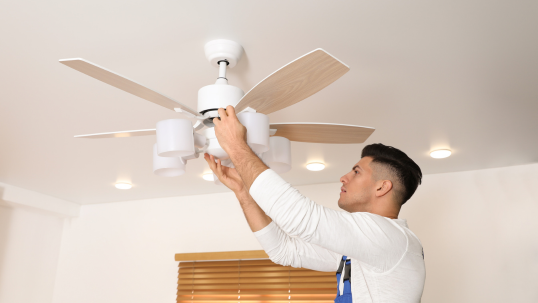Ceiling Fan Sizes: A Guide
Easy to install, easy to use, and with a tiny electrical demand—of the many modern energy efficiency technologies, it’s tough to beat the ceiling fan. In fact, ceiling fans can play a key role in lowering your home’s energy costs in Clearwater, St. Petersburg, Tampa Bay, or the surrounding areas! Learn how to choose the correct size ceiling fan and keep it spinning year-round to maximize savings!
How to Size a Ceiling Fan (and Why It Matters)
Choosing the correct size ceiling fan ensures efficiency and adequate air circulation for the desired space. You can usually base your ceiling fan sizing choice on fan diameter and room space. Check out these recommendations from ENERGY STAR:
- Small rooms (< 100 square feet): 29- to 36-inch diameter
- Medium-to-large rooms (up to 400 square feet): 36- to 50-inch diameter
- Large rooms (> 400 square feet): 50- to 70-inch diameter
What if You Get the Wrong Size Ceiling Fan?
If you’re on the fence between ceiling fan sizes, it’s usually best to opt for the smaller option for a couple of reasons. First, a ceiling fan that is too big may be visually or physically overwhelming and inefficient. Plus, your fan might make your home feel like a whirlwind if it's too powerful! Of course, choosing a ceiling fan that is too small won’t circulate air efficiently, limiting its effectiveness.
Your FAST of Florida technician will help determine your space's ideal ceiling fan size.

The Most Common Types of Ceiling Fans
There are different types of ceiling fans based on how they are mounted, their materials, and their style. Two popular options are standard (or downrod) mount ceiling fans and flush mount ceiling fans.
- Standard/downrod mount ceiling fans: Downrod ceiling fans hang from a vertical post, which positions the fan away from the ceiling to optimize airflow. The length of the downrod is adjustable on most models.
- Flush mount ceiling fans: Ideal for rooms with low ceilings, flush mount ceiling fans install directly against the ceiling to maximize headroom.
Ceiling Fan Aesthetics
When it comes to aesthetics, ceiling fans commonly fall into distinct design families such as traditional, modern, rustic, and industrial. Their adaptability shines through their ability to either command attention as a striking focal point with daring designs or seamlessly blend into a room with understated hues.
Once you’ve found the perfect fit, let us handle the hard part. For ceiling fan wiring and installation support in Clearwater, contact our experienced team today!
Your Ceiling Fan Maintenance Checklist
Ceiling fans do need maintenance, but much of the work is quick and easy. By following these tips, you can avoid unexpected issues and ceiling fan repairs.
Remember, always turn off the fan before cleaning or adjusting your fan—safety first!
Clean Your Ceiling Fan: Every 1-3 Months
Wiping down fan blades every one to three months removes dust buildup. Use a microfiber cloth to wipe the top and bottom of the blade. Some homeowners also use a pillowcase—you can wrap the blade in it to remove dust and trap it inside.
Make sure to clean the light, too, if your fan has one.
Semi-Annual Tune-Ups: Every 6-12 Months
Consider giving your fan a quick tune-up every spring or fall, especially when you change its direction.
- Ensure secure fastening of all screws across the blade assemblies, motor casing, and mounting structure.
- Conduct a thorough visual examination of the fan's wiring, looking for any indications of wear or exposed conductors.
- Refresh the power source of the wireless remote by installing new batteries (especially if a significant period has passed).
- Address lubrication needs based on the fan's age and type. For older models with oil ports, apply a non-detergent oil such as SAE 10W or SAE 20W. Contemporary fans typically feature sealed bearings and do not require this maintenance. Consult your owner's guide for any model-specific lubrication directives.
What Direction Should a Ceiling Fan Go In the Summer?
Get the most out of your ceiling fan by changing its rotation direction seasonally. Most units have a simple toggle switch to change direction, though some require a screwdriver.
- The ceiling fan direction for summer is counterclockwise. A counterclockwise-spinning fan pushes air downwards, creating a cool breeze and enhancing your home’s natural airflow.
- The ceiling fan direction for winter is clockwise. Warm air rises, which means heat tends to gather near the ceiling. A clockwise-spinning fan pulls cooler air up, forcing warm air down along the walls and back into the center of the room.
Read more: Here’s How To Make Your Home More Energy Efficient
Trust the Ceiling Fans Experts in Clearwater
From sizing and selection to wiring a ceiling fan, we’re the Pinellas County area’s go-to source for expert ceiling fan services. Our experienced technicians will keep your fan spinning for years to come. Count on FAST of Florida for all your home service needs!
Contact us online or call 727-273-7810 to get started today!

